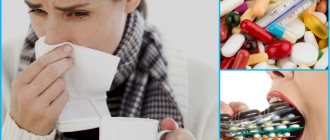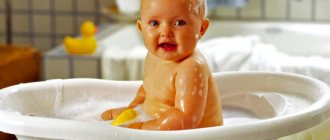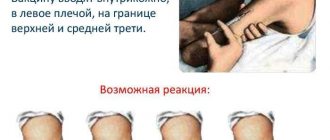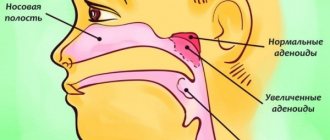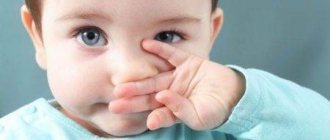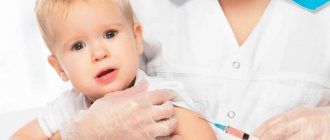Often, during treatment in a hospital setting, parents wonder how to restore the baby’s immunity after antibiotics. Today, this is a pressing issue that needs to be addressed immediately after antibiotic therapy in order to restore normal microflora in the body. Any antibacterial drugs cause complications in the health of an infant.
According to E. Komarovsky, antibacterial drugs prescribed for any person, not just infants, are dangerous due to their harmful effects. Antibiotics fight “bad” bacteria during infections and viruses, but along with them, those microelements that are beneficial are also destroyed. That is why in case of acute infections one cannot do without such remedies, but it is necessary to correctly determine ways to restore the microflora in the baby’s body.
Children say! Tanya (7 years old) is packing her backpack for school and says that tomorrow they will have art and she needs brushes. I give her one brush, and she asks for another one, but so that hair
is thinner!
The danger of antibacterial drugs for humans is determined by the following consequences:
- disruption of the gastrointestinal tract (stool changes, allergic reactions occur);
- thrush may appear on the child’s mucous membrane;
- other fungal infections develop;
- The child’s immunity decreases due to the formation of unfavorable microflora.
According to Dr. Komarovsky, you can restore a baby’s immunity after antibiotics in various ways that are individually suitable for your child. In such a situation, it is better not to neglect the consultation of your pediatrician.
Note to moms! Colds and acute respiratory infections are not treated with antibacterial drugs, since they are not able to affect these viruses in the baby’s body, and doctors simply play it safe when prescribing them.
Watch a video about methods of rehabilitation after antibiotics for a child.
Ways to restore infant immunity after antibiotics
Any method of restoring microflora is selected specifically for each child. For example, in order to restore the immunity of a child who is still breastfed, it is enough to reduce the consumption of complementary foods and “adult” foods (if they are introduced) and increase the frequency of breastfeeding. This method is due to the fact that mother’s milk contains bifido factor (growth factor of “good” bacteria), which is capable of restoring the baby’s microflora in a short time.
Children say! - Tim, who poured crumbs under the table for us? Timokha (4 years old): - Not me. - And not me. What kind of pest is this that sprinkles crumbs under our table? - It's probably grandma - a tiny pest.
If the baby is artificial, you should offer him more liquid food, it is advisable at this time to select more adapted mixtures with a composition of beneficial bacteria. After taking antibiotics, you need to use special drugs for children that increase immunity. This may be Linex, Lactobacilli, Bifidobacteria and other suitable agents.
It is also necessary to improve the child’s nutrition. In order to restore the baby's immunity after antibiotics, it should be made as balanced as possible, including fermented milk products, vegetables and fruits enriched with useful components and vitamins. This list includes apples, bananas, pears, and apricots. For dairy products, it is recommended to consume cheese, feta cheese, and yoghurt. When breastfeeding, these products should be used in the mother's diet.
In addition to proper nutrition and restorative medications, you must follow the following tips:
- carry out daily wet cleaning of the house with dusting;
- take your child for walks in the fresh air more often;
- avoid contact with sick people;
- provide the baby with a comfortable sleep;
- maintain optimal room temperature and humidity.
Attention! To restore immunity after antibiotics, some children need help with the functioning of the gastrointestinal tract. For this purpose, the drug Creon for children is prescribed. It is given to the baby several times a day. This medicine helps improve digestive function.
Remember that it takes at least three weeks after antibacterial therapy to restore the microflora, otherwise do not expect a positive result.
Don't forget to watch the helpful video.
It must be admitted that today every child and parents are familiar with antibiotics, since pediatricians prescribe them with or without reason - as a safety net and just in case. What are antibiotics
?
What are they? In what cases are they prescribed and what are the rules for their use
?
As a rule, what scares moms and dads is not the process of taking antibiotics itself, but how to then live with this “burden” - strengthen the body, reduce the harmful effects of drugs, and the like. First of all, young and not so young parents need to remember this important fact: diseases are divided into viral and bacterial, and only bacterial infections are treated with antibiotics.
All people should understand that an antibiotic cannot be taken “just in case”; there must be indications for taking it. An antibiotic is a serious medicine; you need to know how to use it, and prescribe it only when you cannot do without it. The main thing you need to understand is that an antibiotic can save a life in a certain situation, but it often happens that people use antibiotics unnecessarily just to please the manufacturers. In 99% of cases, bronchitis in children is a viral infection and, naturally, no bronchitis can be treated with an antibiotic. An antibiotic kills bacteria, it has no effect on viruses.
The ability of antibiotics to destroy the intestinal flora is too exaggerated; if you use modern, low-toxic antibiotics and an adequate course, then this will not affect the intestinal microflora. But if you use old-generation antibiotics for several weeks, then such a powerful course can greatly disrupt the microflora. Today there are many antibiotics that, in principle, do not act on the intestines. If a child has been diagnosed with a sore throat, then the doctor knows that in 90% of cases a sore throat is caused by a microbe called streptococcus and in 10% is caused by staphylococcus, and an experienced doctor can distinguish streptococcal from staphylococcal sore throat by symptoms. In medicine, there is such a thing as an antibiotic of choice, which is when a specific antibiotic is prescribed that is effective against a given infection. There are 2 types of antibiotics: 1. Bactericidal - antibiotics that kill bacteria; 2. Bacteriostatic are antibiotics that prevent bacteria from multiplying. When bactericidal drugs are used, the effect is immediate, and when the bacteriostatic effect occurs later. If a person was prescribed a bactericidal drug and it did not have an effect within 24 hours, then either it was prescribed in vain, or it needs to be replaced, but there is no need to wait three days. The duration of antibiotic therapy is individual for each disease, for example, for pneumonia, a course of 5-7 days is enough, but for kidney disease or otitis media, sometimes it is necessary to treat for 2 weeks, since if you stop taking the drug ahead of time, the likelihood of relapse increases tenfold.
How to restore the body after antibiotics?
Microbes are divided into two huge groups: viruses and bacteria. There are no drugs that can kill viruses, but there are antibacterial drugs that can subside and suppress the proliferation of bacteria. Parents can only know whether an antibiotic is needed or not, and what microorganism caused the disease. Most childhood diseases are viral infections and these diseases are accompanied by cough, snot, fever or sore throat. However, there are bacterial infections, and then treatment with antibiotics is necessary.
Treatment with antibiotics can lead to negative consequences, since they have a whole range of side effects and we must know how to properly interact with these drugs. Antibiotics are taken only when they are needed; these are not drugs that are taken just in case. If you did take antibiotics, your child had a serious bacterial infection that required antibiotic treatment. The doctor tells his visitors that when an abscess appears on the skin, there is absolutely no need to ask questions about who caused it, because medical science knows 100% that it is caused by one single microbe, which is called Staphylococcus aureus. The doctor says that in the human body there is a whole bunch of bacteria that constantly fight among themselves, and as soon as we kill some, others become easier. When we took antibiotics, we killed half of the microbes and it is quite possible that the remaining staphylococcus becomes very good and begins to multiply. The doctor explains to the parents that taking antibiotics kills the microflora in the intestines, where the bulk of the immune system is located. The most important thing at the stage of restoring immunity after taking antibiotics is not to pick up a new infection. And the main source of infection for children is people; the more people around, the greater the likelihood of catching something new. Therefore, it is important, after we have recovered and been treated with antibiotics, not to run to our children for a new infection, but to limit visiting public places for 5-7 days and walk more in the fresh air. Usually the opposite happens, as soon as the child has somehow recovered and his temperature has dropped, it’s time for the mother to go to work and the child goes to the children, where he very quickly picks up something new.
8 misconceptions of antibiotic therapy (According to Komarovsky)
1. Act on viruses
For viral infections, antibiotics do not work, do not help and do not improve anything except the material well-being of manufacturers and sellers of antibacterial agents!!!
2. Have a preventive effect against viral infections
Antibiotic therapy is not able to reduce the likelihood of bacterial complications. Complications still arise, but they are associated with bacteria that survived the antibiotic prescribed in vain. Consequently, another drug is needed, and this “other”, as a rule, is noticeably more expensive than the original one - in vain.
3. There are strong and weak
Our average compatriot is inclined to link the power of an antibiotic with its ability to empty pockets and purses. People really want to believe in the fact that if antibiotic “A” is a hundred times more expensive than antibiotic “B”, then it is also a hundred times more effective. But that was not the case... All very expensive drugs are used only in very serious and, fortunately, not very frequent situations, when a specific disease is caused by a microbe that is resistant to the action of most drugs, when there is a pronounced decrease in immunity, when the condition is so severe, that very fast and very effective help is required.
4. They “set down” the immune system
None of the modern antibacterial agents have an inhibitory effect on the immune system. Here, as all too often with us, cause and effect are confused. The disease is to blame for the suppression of the immune system, which was the reason for prescribing antibiotic therapy.
5. Antifungal drugs should be taken along with antibiotics
Candidiasis - as a specific side effect of antibiotic therapy - is quite possible, and its development can indeed be treated with the use of antifungal agents.
But there is no evidence that antifungal drugs have a preventative effect and reduce the likelihood of candidiasis. For “prevention”, drugs such as nystatin and fluconazole are most often used (prescribed).
Result: the patient eats unnecessary medicine; money is wasted unnecessarily; candidiasis (caused by fungi resistant to this medicine) still occurs, so you need to prescribe (purchase) another remedy - stronger, more active, more expensive.
6. When taking antibiotics, you must take medicines “for the intestines”
Inhibition of intestinal flora, so severe that it requires treatment, is a fairly rare phenomenon. It occurs with long-term use of broad-spectrum antibiotics, especially when taking an antibiotic is accompanied by experiments with nutrition - force-feeding, abuse of fatty foods.
However, diet combined with stopping antibiotic therapy is quite sufficient treatment, since the intestinal flora is restored very quickly.
It is not surprising that most magic bacteria capsules are drugs with unproven effectiveness.
7. Antiallergic drugs are required during antibiotic therapy
Example-explanation. The boy Petya is allergic to ampicillin. But we don't know that yet. The child took an ampicillin tablet, an itchy rash appeared an hour later, and the antibiotic was stopped.
The second scenario. Along with ampicillin, the boy was given the antiallergic drug Suprastin. The rash did not appear immediately, but after the third ampicillin tablet. Thus, instead of one tablet of ampicillin, which was contraindicated for him, Petya received three tablets. Whether this is better or worse is a rhetorical question.
Summary: Antibiotic-related allergies are indeed not uncommon. Hence the important rule - a drug that causes an allergic reaction must be immediately discontinued and replaced with a drug from another group.
8. If it gets worse after taking an antibiotic, it should be stopped immediately and replaced
Under the influence of antibiotics, bacteria can be destroyed, and this is accompanied by the release of so-called endotoxins into the blood. The body reacts to the release of endotoxins with chills and increased body temperature - all this manifests itself as a real deterioration of the condition on the first day of treatment. This development is called an “endotoxic reaction,” and doctors are specifically taught how to distinguish endotoxic reactions from drug failure.
Summary: if after swallowing a tablet or injection of an antibiotic the temperature rises and chills begin, this does not mean at all that this drug is not suitable and you need to run to the pharmacy for another one. This means that you need to consult a doctor.
Most childhood illnesses, such as influenza or acute respiratory infections, are caused by viruses. In such cases, parents are required to help the baby’s body cope with the illness on its own. But there are a number of diseases that are caused by bacteria. Often these infections need to be treated with antibiotics.
Sensible parents understand that antibiotics are incompatible with self-medication. Only a doctor can prescribe such medications, because each antibiotic acts on the body in its own way, each has its own spectrum of action, routes of elimination from the body and side effects. But there are a number of subtleties that parents should be aware of if their child is prescribed antibiotics. Children's doctor, candidate of medical sciences, popular TV presenter Evgeniy Komarovsky will talk about them.
Follow instructions and treatment times
Do not let the doctor leave until you receive the clearest instructions on how to use the antibiotic, emphasizes Evgeniy Komarovsky. — Some drugs need to be given to the child before meals, others after, and others whenever. There are some that cannot be combined with milk. Some antibiotics are given only once a day, others two, three or four times.
It is also important not to stop taking antibiotics prematurely, even if the baby has improved significantly.
For example, with pneumonia, 5-7 days of treatment is usually enough, and otitis media or kidney disease takes two weeks to treat,” explains Evgeniy Olegovich. — If you stop the medicine earlier, the likelihood of relapse increases tenfold. Moreover, a new infection will be caused by a microbe that has survived the antibiotic, and another, stronger medicine will have to be prescribed.
It is better to exceed the dose than to reduce it
Sometimes parents think that the amount of medicine prescribed by the doctor is too much, especially for the baby. But you can’t reduce the dose on your own! There is a risk that too many living microbes will survive in the body.
Modern drugs are mostly low-toxic, and exceeding the dose even two to three times is less risky than reducing it by 10%. Therefore, if you are not sure that the baby swallowed the entire spoon of syrup and did not spit out half, play it safe and give him another one.
Improvement may not occur immediately
Be prepared for the fact that after starting antibiotic treatment, your child may become even worse for some time. The reason is toxins that enter the blood as a result of the destruction of bacteria.
If after taking an antibiotic the temperature rises and chills begin, this does not mean at all that this drug is not suitable and you need to run to the pharmacy for another, emphasizes Evgeniy Olegovich. “Only a doctor can tell whether this reaction is normal or not.”
Another nuance: there are two types of antibiotics - bactericidal and bacteriostatic. The former kill bacteria, the latter do not allow them to multiply, while the body itself destroys the remnants of their colonies. The first type of antibiotics causes improvement within 24 hours, and if this does not happen, the doctor will most likely change the medicine to a more effective one.
Should I take something along with antibiotics?
As a rule, in order to reduce the negative consequences of taking an antibiotic, the doctor also prescribes an antihistamine and a drug to normalize the intestinal microflora.
Indeed, an antibiotic can cause an allergy in a child, but it is better to find out about this immediately, that is, after the first dose, says Dr. Komarovsky. “If we start treatment and at the same time start giving an antihistamine, a rash or other reaction will still appear, but after three or four doses. Why wait so long if you could immediately replace the drug with its analogue?
As for drugs for normalizing intestinal microflora, Evgeniy Komarovsky believes that a proper diet during and after an illness is much more important than taking such medications, the effectiveness of which, by the way, has not been proven.
Don’t overfeed your child, don’t stuff him with sweets and “chemicals,” and the intestinal flora will restore itself, and quite quickly, emphasizes Evgeniy Olegovich.
Do antibiotics damage the immune system?
It is not necessary to take immunostimulating drugs after antibiotic treatment; the main thing is to protect the baby as much as possible from the danger of contracting another disease.
If possible, do not go to kindergarten for as long as possible by hiring a nanny or asking your grandmother, do not drag your child shopping, do not take him to the circus or the theater for some time, avoid low-quality products that can cause an intestinal infection, lists Evgeniy Komarovsky. - Walk more, ventilate and humidify the air in the nursery. It would be enough!
The same antibiotic won't work a second time
It happens that the disease recurs, but the parents do not call a doctor - they say they already have a ready-made treatment regimen. But this is a mistake that can have serious consequences. Firstly, the risk of an allergy to an already used drug increases many times over. Secondly, there is a possibility that there are bacteria in the child’s body that survived the previous course. Therefore, you need to prescribe a drug from a different group.
Remember the rule - always write down when, under what circumstances, with what drugs and in what doses your child was treated before
Summary: Treatment with antibiotics. What antibiotics to take and in what cases. Action of antibiotics. Consequences of taking antibiotics. Antibiotics for sore throat. Antibiotics for children.
Antibiotics were discovered in the 20th century, and at one time it was a huge event. There are a lot of diseases that cannot be treated without antibacterial therapy, and before the discovery of antibiotics, people died en masse from these diseases. But antibiotics are a serious drug; each time you need to look and decide whether the child really needs it at the moment. According to American scientists, in every second (!) case, antibiotics are taken for other purposes, causing unjustified harm to human health. In this article we will list the mandatory rules for taking antibiotics.
Restoration of the body
How to quickly recover a child after taking antibiotics:
- Spend more time outdoors;
- Forget about hardening for a while, but do not ignore wet cleaning and daily ventilation;
- Make sure you eat healthy and drink plenty of fluids. The child's food should be rich in vitamins and minerals. First of all, you need to include vegetables and fruits in the menu;
- Create a healthy environment at home and temporarily exclude contact with other children.
Note! Doctors recommend, if possible, feeding a baby with breast milk for at least 6 months, preferably up to a year. This will help strengthen the immune system, defeat the disease faster, and avoid the unpleasant consequences of therapy, in particular, dysbacteriosis.
Doctors' recommendations
You need to take antibiotics according to the instructions. It is necessary to maintain equal periods of time between doses. If today you give medicine at lunch, then the next day you need to do the same. When you need to drink water, you cannot use other liquids, including milk and formula.
You should not interrupt the course of treatment, otherwise the bad bacteria will have time to become resistant to the drug. Their numbers will remain the same and they will be able to resist therapy. Next time it will turn out to be meaningless, and you will have to look for a new treatment regimen.
Signs of normalization of microflora
When beneficial bacteria repopulate the intestines, and their number exceeds the number of pathogenic organisms, the baby’s stool will return to normal. The baby will begin to go to the toilet in the same way as before, and the previous consistency and frequency of bowel movements will return. The baby will no longer get tired quickly, drowsiness will disappear, and he will return to his normal routine.
Each antibiotic acts on strictly defined microorganisms.
For example, the antibiotic penicillin actively acts on the so-called. cocci - streptococcus, meningococcus, gonococcus, pneumococcus, but does not affect E. coli, dysentery bacillus, salmonella. The antibiotic polymyxin, on the contrary, acts on rods, but does not act on cocci.
It is very important to choose the right antibiotic for treatment, which will be active specifically against the microbe that caused the disease. Any antibiotic should be prescribed only by a doctor! The doctor prescribes a specific antibiotic based on his knowledge, experience, or after conducting a bacteriological study.
Any repeated use of an antibiotic greatly increases the risk of allergic reactions.
Example. The boy Sasha has bronchitis. The doctor prescribed ampicillin, 5 days passed, and things improved significantly. After 2 months, another illness, all the symptoms are exactly the same - experience bronchitis. Let's not bother the pediatrician. We will swallow proven and effective ampicillin. The situation described is very typical. But its consequences are unpredictable. The fact is that any antibiotic is capable of combining with blood serum proteins and, under certain circumstances, becoming an antigen - i.e. induce the production of antibodies. After taking ampicillin (or any other drug), antibodies to ampicillin may be present in the blood. In this case, there is a high probability of developing allergic reactions, sometimes very (!) severe. In this case, an allergy is possible not only to ampicillin, but also to any other antibiotic that is similar in its chemical structure.
There is another important aspect. If the same disease recurs after a short time, then it is quite logical to assume that when it reoccurs, it (the disease) is associated with those microbes that “survived” after the first course of antibiotic therapy, and, therefore, the antibiotic used will not be effective.
Prevention
Is it possible to avoid the consequences of taking antibiotics even at the stage of treating an infection? Quite, since dysbiosis, like any other disease, is easier to prevent than to think about what to give a child after antibiotics for the microflora. Taking probiotics after completing a course of antibacterial therapy is necessary in any case, but prevention will help to significantly shorten the recovery period.
Choice of antibiotic
When prescribing a drug for the treatment of an infectious disease to a child, the pediatrician tries to choose the drug that is least dangerous in terms of side effects. High-quality medicines from trusted pharmaceutical companies are usually not cheap, but saving in this case is unacceptable.
Trying to replace a prescribed medicine with an inexpensive analogue, you can cause serious harm to the child’s health and subsequently spend much larger sums on restoring the microflora and immune system.
Drug support during antibiotic therapy
Probiotics should be taken two hours after the antibiotic. This measure will reduce the intensity of manifestations of dysbacteriosis.
Taking immunostimulating drugs and vitamin complexes may also be indicated.
All of the listed groups of medications are prescribed exclusively by a doctor and, if his instructions are followed, will help tolerate antibiotic treatment without negative consequences for the baby’s body.
In his book E.O. Komarovsky also criticizes preventive antibiotic therapy for ARVI.
This is when a child gets sick with some kind of virus, and the doctor, just in case, prescribes him to also take a course of antibiotics in advance so that bacterial complications do not develop. Here's what he writes about this:
“The use of antibacterial drugs for viral infections, supposedly for the purpose of prevention, in order to prevent the development of complications, is unacceptable!
Preventive antibiotic therapy for ARVI is:
Increased frequency and severity of bacterial complications. Because by destroying safe and opportunistic flora, we thus increase the likelihood of colonization of the respiratory tract by microbes that are clearly pathogenic, harmful and undesirable.
Absorption of unnecessary and far from safe medications, accompanied by an unreasonable and unjustified risk of adverse reactions and complications.
Constant selection of microorganisms, leading to a rapid increase in the number of bacteria resistant to many antibiotics.”
Dr. Komarovsky emphasizes that an antibiotic should be prescribed when a bacterial infection already exists, and not in order to supposedly prevent it. As M.M. said Zhvanetsky: “Troubles must be experienced as they arise!”



